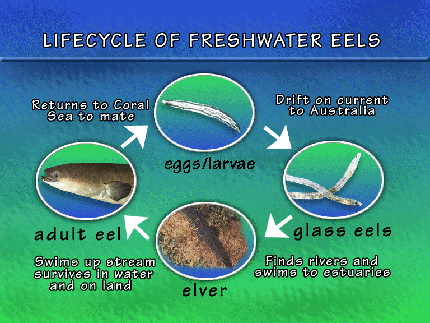Freshwater eels, those big brown slimy things you accidentally hooked when fishing the river with grandpa, deserve a longer look. To get to those fishing holes in creeks and rivers, each eel has travelled about 5000km from its spawning grounds 300m below the Coral Sea, somewhere between Fiji and Samoa (see map).
The eel starts life as a clear larvae hatched from an egg, which drifts on currents for about nine months until it is off the coast of Australia.
Here it turns into a glass eel, so-called as it is glass-like in its appearance, which uses its sense of smell to find rivers and swim up into estuaries. At this stage the eel’s metabolism adapts from life in saltwater to life in freshwater. In the rivers the glass eel develops further into an elver, an immature eel, and swims upstream. Small eels have the ability to climb dam walls and go hundreds of metres overland to reach the rivers, creeks and dams where they will spend the next decade or so growing and maturing.
Many eels get trapped in dams and that’s how stories of 60 year old monsters up to three metres long originate. Those that aren’t trapped by dams swim back down to the ocean to make the 5000km trip back to the Coral Sea. Here they breed and each female will release about a million eggs before she dies having completed her life cycle.
Adaptations
If you are lucky enough to see a real freshwater eel one of the first things you’ll notice is how slimy it is. While this makes them hard to hang on to, the slime is actually a coating of mucus that protects them from diseases and predators and helps when wriggling through the grass at night going from one pond to the next.
Another amazing eel feature is their adaptation to hunting. Their eyes are on the tip of their snouts so even in dim water they can see what they’re biting, and they have an acute sense of smell.
Due to their surprising ability to wriggle through grass between creeks and ponds, they are sometimes mistaken for snakes. While we do not recommend taking close looks at creatures thought to be snakes, a freshwater eel can be distinguished by the fins on its back, and gill chambers on the sides of its head.
As well as two sorts of freshwater eels, Australia has about 50 sorts of Moray eels that live in saltwater. While freshwater eels have tiny sandpapery teeth, Morays have very sharp teeth. Although Moray eels are usually placid, most divers avoid them.
While most eels are superbly camouflaged, there are some quite rare colour mutations. We showed a banana-yellow eel which can be seen at the Sydney Aquarium at Darling Harbour.
Eels have had many uses over the centuries; in the 1600s their skin was made into leather for whips and these days its used for a range of high class leather goods. Eel is also a popular menu item in Europe and Asia.
Further information
The Sydney Aquarium is at Pier 26, Darling Harbour, NSW, 2000. Phone: (02) 9262 2300. Admission: Adults – $15.90; Children – $8.00; Students – $10; Seniors – $12. Family – $36.90.
Open daily from 9.30am-10pm (last entry 9pm).
Further reading
The story of the eel’s journey is contained in a book based on a BBC television program. The book of the series is called Incredible Journeys by Nigel Marven and is available from ABC Shops around Australia for $34.95.
For details on farming eels and eels in dams consult Farming in Ponds and Dams by Nick Romanowski (Lothian, 1994). ISBN 0 85091 630 5.



